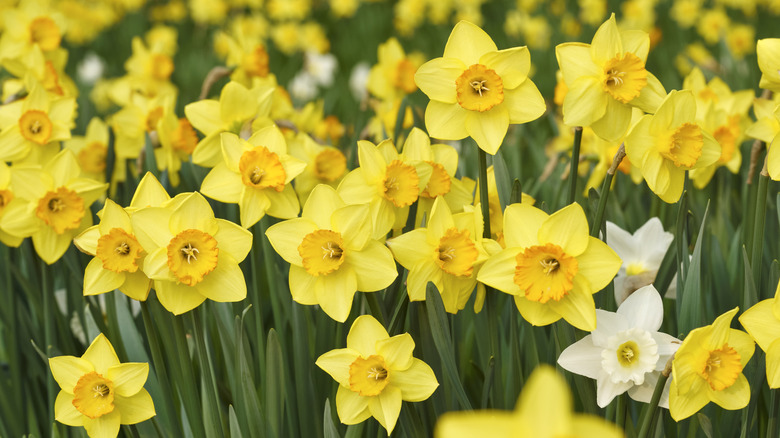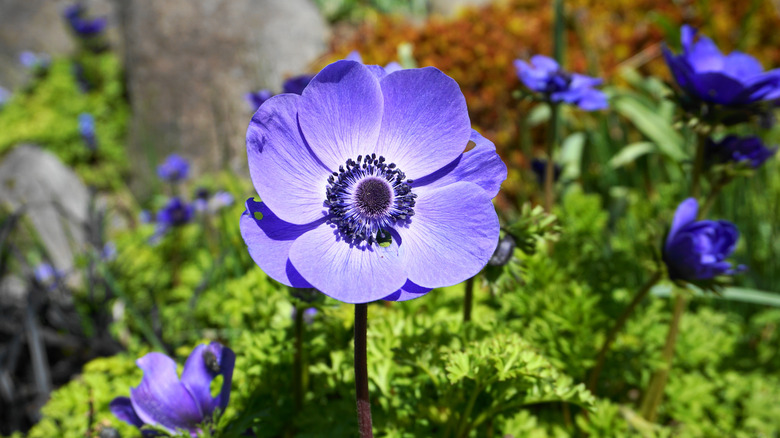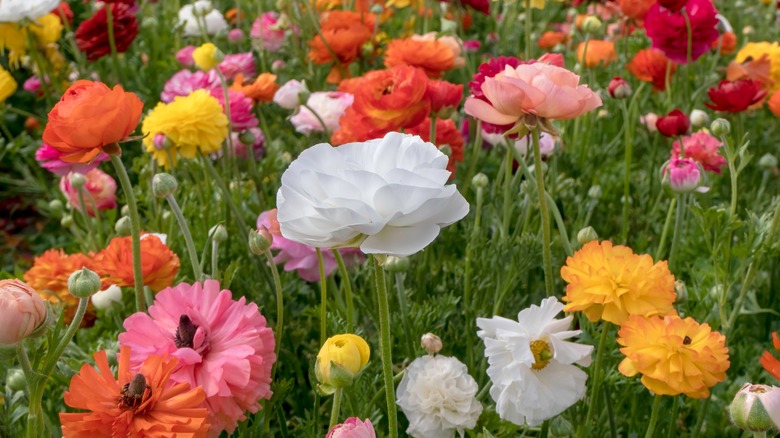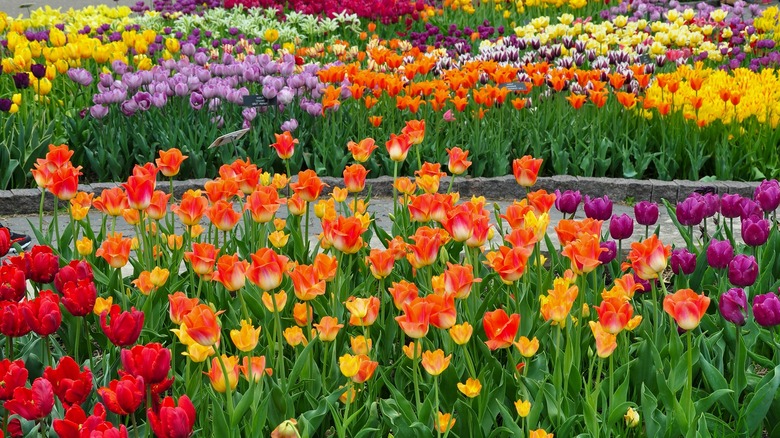Stunning Spring Flowers Joanna Gaines Grows In Her Garden Every Year
Joanna Gaines may be famous for her interior design, but she's no stranger to taking what she knows outside. She recently posted photos of her garden on Instagram, and it's clear she's been applying her knowledge of interior design principles and trends to her flower beds. She's also chosen low-maintenance perennial flowers that will bring spring color to her yard year after year: daffodils, anemones, ranunculi, and tulips.
"As with her interiors, Joanna has struck a balance between functionality and approachable elegance in her North-Central Texas ranch garden," said Nathan Heinrich, a landscape and botanical designer with 15 years' experience, in an interview with Homes and Gardens. Gaines's garden features clean lines and geometric patterns for a sophisticated look that's simple enough to replicate at home. The key? Creating symmetry through low-maintenance elements like raised beds and gravel paths, rather than through hedges and topiaries that would require constant pruning.
Gaines has also applied the recent interior design trend of color blocking to her outdoor space by planting a single type of flower and color family in each bed. This not only creates a more manicured look and allows each flower to shine, but also makes planning and executing the garden simpler. Here are some of her favorite spring flowers to keep in her garden, and how you can incorporate them too.
Daffodils
Daffodils, aka narcissus, are an easy and beautiful choice for your spring garden. They can thrive in either sun or part shade, in most soil types, and in most growing zones in the continental U.S. They're also resistant to common garden pests like deer and rabbits — they can even help keep your yard free of pesky moles. Not only will daffodils continue to pop up every spring without much maintenance, they'll also divide and multiply over time to fill your garden bed with color.
When shopping for daffodils, you'll find a huge variety of flower shapes. For example, trumpet daffodils have a long central "trumpet," while small-cupped and large-cupped daffodils have a smaller cup-like part in the middle. In split-corona daffodils, the central part is split into smaller pieces with wavy edges. Double daffodils have extra petals, giving the illusion of a second flower inside the first. Daffodils also come in a wide range of colors, from the iconic yellow and white to shades of peach, pink, orange, and cream.
When designing your daffodil bed, you can choose whichever shapes and colors you prefer. Daffodils tend to look best when planted in clusters rather than rows, so group your bulbs together for the most dramatic effect. But space the bulbs about six inches apart to give them room to grow and multiply. Since different daffodil cultivars bloom at different times, you may want to combine a few species in your garden to ensure you'll have flowers throughout growing season.
Anemones
There are many types of anemone flowers. The one Joanna Gaines grows in her garden, and the one you've probably seen most often in bouquets, is anemone coronaria. This dramatic bloom is easily recognized by its dark purple or black center, which is reminiscent of a poppy — hence the nickname "poppy anemone." Anemones produce large flowers (up to two inches in diameter) in a range of red, purple, blue, and white shades. They make a good companion plant for daffodils because they bloom around the same time while providing variety in height, shape, and texture.
Like daffodils, anemones are known for being easy to grow. They'll tolerate full sun to light shade, they're hardy in zones 7 to 10, and they can thrive even in the extreme temperature swings of desert climates. They're also resistant to animals like deer and rabbits (but very attractive to bees). Keep in mind that the deer-deterring chemical in anemones, protoanemonin, is toxic if ingested, so keep an eye on children and pets in your garden.
Anemones bloom in mid-to-late spring, and their dramatic flowers can last up to four weeks. Although anemones are hardy in zones 7 to 10, their corms (similar to bulbs or tubers) may not always survive the winter in cold climates. You can protect your flowers by insulating them with mulch in the fall. Or you can dig up the corms each fall, store them at 50 to 55 degrees Fahrenheit, and replant them in the spring.
Ranunculi
Ranunculi (the plural of ranunculus) are another favorite flower in Joanna Gaines's garden. Sometimes called "the rose of spring," the ranunculus produces a round, rose-like flower with many thin, overlapping petals. This plant is slightly more difficult to pronounce than the others on our list, and it can be more difficult to grow.
Ranunculi are winter-hardy only in zones 8 to 10. If you live in a colder region, you can plant ranunculus corms in late winter or early spring, but they won't bloom until early summer. To encourage them to bloom sooner, you can pre-sprout the corms indoors before planting. Soak ranunculus corms for three to four hours in a bowl of room-temperature water, with a trickle running from the faucet into the bowl to keep the water from becoming stagnant. Then bury the corms in a seed tray in about two inches of damp potting soil, and store them in a dark area at 50 to 60 degrees Fahrenheit. After about a week and a half, you should see white roots emerging from the corms — that means they're ready to plant.
Ranunculi contain protoanemonin, the same toxin found in anemones, so keep them away from children and pets. Although their toxicity protects them from animals, ranunculi are very susceptible to powdery mildew. You can prevent this by keeping their foliage dry and well-ventilated. Plant corms at least six inches apart to allow airflow, and always water the soil rather than the plant to keep the leaves dry.
Tulips
Though this spring staple is often associated with the Netherlands, tulips actually originated in central Eurasia and were made famous after being brought to the Netherlands from Turkey. Since then, heavy cultivation has produced a huge variety of tulips. You can choose to combine several types into a tapestry of color, or try Joanna Gaines's color blocking technique. You can plant tulip bulbs close together for maximum impact, and you can scatter the bulbs (rather than planting them in rows or grids) for a soft, natural look.
To promote beautiful flowers, feed your tulips with a granular bulb fertilizer when the foliage first emerges from the ground, then switch to a liquid fertilizer after blooms start to open. Also keep an eye out for botrytis, a type of fungus that loves tulips. If you spot gray fuzz on your tulips' leaves, immediately remove and discard the entire infected plant, bulb and all, to prevent the fungus from spreading.
After your tulip flowers run their course, remove the dead flower head before it turns into a seed pod. This prevents the plant from pouring its precious energy into making seeds and instead redirects that energy to the bulb, which will store it over the winter. Don't cut off or otherwise disturb the foliage as it wilts and turns yellow, either. It's still photosynthesizing and sending energy to the bulb. The more energy your tulips store over the winter, the bigger and more beautiful their blooms will be next year.




